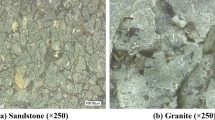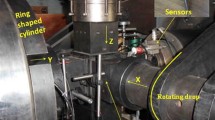Abstract
Rock failure is a serious problem in rock engineering environments. Rock failure modes, however, are complex and difficult to quantify or predict. A comprehensive study on rock failure modes at laboratory scale is, therefore, potentially important as it helps recognize the adequacy of the support designed on the basis of the nature of an engineering work. With due need, this paper analyzes the failure modes of granite, schist, and sandstone under uniaxial compression, Brazilian, and point load tests in relation to corresponding strengths. The nature of the principal failure mode changes from axial splitting to shearing along a single plane to multiple fracturing in the case of both granite and sandstone specimens as uniaxial compressive strength (UCS) increases. In the case of schist, specimens failed at low UCS show failure along foliations whereas specimens which do not fail along foliations portray high strength. The relation between failure modes of all three rocks under uniaxial compression and corresponding UCS values was broadly explained in terms of damage evolution of the rocks. Granite and sandstone specimens failed mainly following central or central multiple type of fracturing whereas schist specimens principally failed by layer activation in combination with either central or non-central fractures over the entire range of determined Brazilian tensile strength. In the case of granite and sandstone, central multiple failure mode corresponds to high tensile strength. Descriptions of different failure modes under point loading were presented. It was found that granite and sandstone specimens generally fail through the rock materials in one or more extensional planes containing the line of loading. Failure patterns showing triple junctions correspond to high point load strength indices. In the case of schist, specimens failed along foliations show a low point load strength index whereas specimens failed through material with a single extensional plane result in high strength.


















Similar content being viewed by others
References
Akesson U, Hansson J, Stigh J (2004) Characterization of microcracks in the Bohus granite, western Sweden, caused by uniaxial cyclic loading. Eng Geol 72:131–142
Amann F, Button EA, Evans KF, Gischig VS, Blumel M (2011) Experimental study of the brittle behavior of clay shale in short term unconfined compression. Rock Mech Rock Eng 44:415–430
Geological Society Engineering Group Working Party (1995) The description and classification of weathered for engineering purposes. Q J Eng Geo 28:207–242
ASTM (2001) American Society for Testing and Materials. ASTM Standards on Disc, 04.08. West Conshohocken, PA
Aydin A, Basu A (2006) The use of Brazilian test as a quantitative measure of rock weathering. Rock Mech Rock Eng 39:77–85
Basu A (2006) Mechanical characterization of granitic rocks of Hong Kong by improved index testing procedures with reference to weathering induced microstructural changes. PhD thesis, The University of Hong Kong
Basu A, Aydin A (2006) Predicting uniaxial compressive strength by point load test: significance of cone penetration. Rock Mech Rock Eng 39:483–490
Basu A, Kamran M (2010) Point load test on schistose rocks and its applicability in predicting uniaxial compressive strength. Int J Rock Mech Min Sci 47:823–828
Basu A, Celestino TB, Bortolucci AA (2009) Evaluation of rock mechanical behaviours under uniaxial compression for different weathering grades. Rock Mech Rock Eng 42:73–93
Bieniawski ZT (1967) Mechanism of brittle fracture of rock: part I—theory of the fracture process. Int J Rock Mech Min Sci Geomech Abstr 4:395–406
Bieniawski ZT (1984) Rock mechanics design in mining and tunneling. AA Balkema, Rotterdam
Bieniawski ZT (1989) Engineering rock mass classifications. Wiley, New York
Bobet A, Einstein HH (1998) Fracture coalescence in rock-type materials under uniaxial and biaxial compression. Int J Rock Mech Min Sci 35:863–888
Brace WF, Paulding BW, Scholz CH (1966) Dilatancy in the fracture of crystalline rocks. J Geophys Res 71:3939–3953
Brook N (1985) The equivalent core diameter method of size and shape correction in point loads testing. Int J Rock Mech Min Sci Geomech Abstr 22:61–70
Cargill JS, Shakoor A (1990) Evaluation of empirical methods for measuring the uniaxial compressive strength of rock. Int J Rock Mech Min Sci Geomech Abstr 27:495–503
Chau KT, Wong RHC (1996) Uniaxial compressive strength and point load strength. Int J Rock Mech Min Sci Geomech Abstr 33:183–188
Eberhardt E, Stead D, Stimpson B, Read RS (1998) Identifying crack initiation and propagation thresholds in brittle rock. Ca Geotech J 35:222–233
Ghosh DK, Srivastava M (1991) Point-load strength: an index for classification of rock material. Bull Eng Geol Env 44:27–33
Hudson JA (1989) Rock Mechanics principles in engineering practice. CIRIA Report, Butterworths, London
Hudyma N, Avar BB, Karakouzian M (2004) Compressive strength and failure modes of lithophysae-rich Topopah Spring Tuff specimens and analog models containing cavities. Eng Geol 73:179–190
Hutchison CS (1974) Laboratory handbook of petrographic techniques. Wiley, New York
ISRM (2007) The complete ISRM suggested methods for rock characterization, testing and monitoring: 1974–2006. In: Ulusay R, Hudson JA (eds) Suggested methods prepared by the commission of testing methods, ISRM, compilation arranged by the ISRM Turkish national group, Kozan Ofset, Ankara
Jaeger JC, Cook NGW (1979) Fundamentals of rock mechanics, 3rd edn. Chapman & Hall, London
Jaeger JC, Cook NGW, Zimmerman RW (2007) Fundamentals of rock mechanics, 4th edn. Blackwell, Oxford
Jumikis AR (1983) Rock mechanics, 2nd edn. Trans Tech Publ, Clausthal
Klein E, Baud P, Reuschle T, Wong TF (2001) Mechanical behavior and failure mode of Bensteim sandstone under triaxial compression. Phys Chem Earth (A) 26:21–25
Lajtai EZ, Lajtai VN (1974) The evolution of brittle fracture in rocks. J Geol Soc Lond 130:1–16
Li L, Lee PKK, Tsui Y, Tham LG, Tang CA (2003) Failure process of granite. Int J Geomeh 3:84–98
Mahur AK, Kumar R, Sonkawade RG, Sengupta D, Prasad R (2008) Measurement of natural radioactivity and radon exhalation rate from rock samples of Jaduguda uranium mines and its radiological implications. Nucl Instrum Methods Phys Res B 266:1591–1597
Maji VB (2011) Understanding failure mode in uniaxial and triaxial compression for a hard brittle rock. In: Proceedings of the 12th ISRM international congress on rock mechanics. CRC Press/Balkema, Leiden, pp 723–726
Martin CD (1993) The strength of massive Lac du granite around underground openings. PhD thesis, University of Manitoba
Martin CD, Chandler NA (1994) The progressive fracture of Lac du Bonnet granite. Int J Rock Mech Min Sci Geomech Abstr 31:643–659
Panigrahi MK, Bream BR, Misra KC, Naik RK (2004) Age of granitic activity associated with copper–molybdenum mineralization at Malanjkhand, Central India. Miner Deposita 39:670–677
Peng S, Johnson AM (1972) Crack growth and faulting in cylindrical specimen of chemsford granite. Int Int J Rock Mech Min Sci Geomech Abstr 9:37–86
Rocco C, Guinea GV, Planas J, Elices M (1999) Mechanisms of rupture in splitting tests. ACI Mater J 96:52–60
Saha AK (1994) Crustal evolution of Singhbhum North Orissa, Eastern India. Geol Soc India Memoir 27:281–307
Sammis CG, Ashby MF (1986) The failure of brittle porous solids under compressive stress state. Acta Metall 30:511–526
Santarelli FJ, Brown ET (1989) Failure of three sedimentary rocks in triaxial and hollow cylinder compression tests. Int J Rock Mech Min Sci Geomech Abstr 26:401–413
Scholz C (1968) Experimental study of the fracturing process in brittle rock. J Geophys Res 73:1447–1454
Sengupta S (2003) Gondwana sedimentation in the Pranhita–Godavari valley: a review. J Asian Earth Sci 21:633–642
Szwedzicki TA (2007) A hypothesis on modes of failure of rock samples tested in uniaxial compression. Technical note. Rock Mech Rock Eng 40:97–104
Tavallali A, Vervoort A (2010) Effect of layer orientation on the failure of layered sandstone under Brazilian test conditions. Int J Rock Mech Min Sci 47:313–322
Tugrul A, Zarif IH (1999) Correlation of mineralogical and textural characteristics with selected granitic rocks from Turkey. Eng Geol 51:303–317
Vutukuri VS, Lama RD, Saluja SS (1974) Handbook on mechanical properties of rocks. Trans Tech Publ, Clausthal
Acknowledgments
The authors thank to Prof. Ulusay and an anonymous reviewer for their comprehensive review of the manuscript that helped enhance the quality and clarity of this paper. The financial support (Project Number SR/FTP/ES-03/2008) by the Department of Science and Technology (DST, New Delhi, India) is gratefully acknowledged. The authors thank the Malanjkhand Copper Project, Uranium Corporation of India Limited, and Singareni Colliery Company Limited for providing granite, schist, and sandstone cores, respectively, for academic purposes.
Author information
Authors and Affiliations
Corresponding author
Rights and permissions
About this article
Cite this article
Basu, A., Mishra, D.A. & Roychowdhury, K. Rock failure modes under uniaxial compression, Brazilian, and point load tests. Bull Eng Geol Environ 72, 457–475 (2013). https://doi.org/10.1007/s10064-013-0505-4
Received:
Accepted:
Published:
Issue Date:
DOI: https://doi.org/10.1007/s10064-013-0505-4




